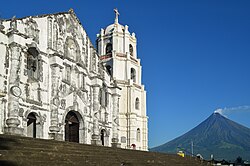
Earthquake Baroque, or Seismic Baroque, is a style of Baroque architecture found in the Philippines and in Guatemala, which were Spanish-ruled territories that suffered destructive earthquakes during the 17th and the 18th centuries. Large public buildings, such as churches, were then rebuilt in a Baroque style during the Spanish colonial periods in those countries. [1]
Contents
Similar events led to the Pombaline architecture in Lisbon following the 1755 Lisbon earthquake and Sicilian Baroque in Sicily following the 1693 earthquake.

 Top to Bottom: Panay church entrance with view of façade Pilasters, Paoay church buttresses.
Top to Bottom: Panay church entrance with view of façade Pilasters, Paoay church buttresses.








